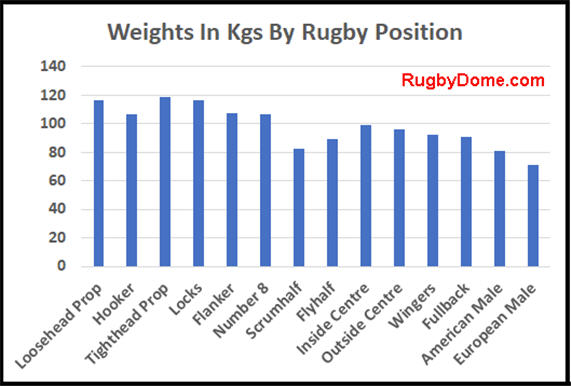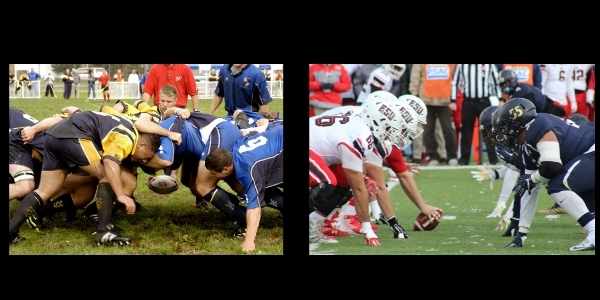Professional rugby players are heavier on average than the general population.
Props are the heaviest players in Rugby Union with an average weight of 118 kgs (18st 8lbs). Locks are the next heaviest players on the field.
This article looks in-depth at how the different positions stack up against each other and against the general population.
It’s important to know that rugby positions vary greatly in weight. If you want to take up the sport and are heavier or lighter than your friends, some positions may be perfect for you!
How Heavy Are Professional Rugby Players?
This chart shows the average weights of male professional players in 2019 across the three big European domestic competitions:
- English Premiership
- French Top 14
- United Rugby Championship (Scotland, Wales, Ireland, Italy at the time).
The positions are ordered by jersey number.

This table has the raw data in the chart:
| Position | kg | st/lbs | lbs |
| Loosehead Prop | 116.67 | 18st 5lbs | 257 |
| Hooker | 106.33 | 16st 10lbs | 234 |
| Tighthead Prop | 119.00 | 18st 10lbs | 262 |
| Locks | 116.40 | 18st 4lbs | 256 |
| Flanker | 107.17 | 16st 12lbs | 236 |
| Number 8 | 106.33 | 16st 10lbs | 234 |
| Scrumhalf | 82.33 | 12st 13lbs | 181 |
| Flyhalf | 89.33 | 14st | 196 |
| Inside Centre | 99.17 | 15st 8lbs | 218 |
| Outside Centre | 95.67 | 15st | 210 |
| Wingers | 92.50 | 14st 7lbs | 203 |
| Fullback | 90.33 | 14st 3lbs | 133 |
| U.S. male | 80.70 | 12st 10lbs | 178 |
| European male | 70.80 | 11st 2lbs | 156 |
I haven’t split out the locks between numbers four and five because there is very little difference. Similarly, the left and right wingers are pretty much the same.
However, there is a significant difference between the inside and outside centre.
Summary
The average weight across all rugby positions is 218 lbs or 102 kg.
The average weight across the forwards (numbers 1-8) is 246 lbs or 112 kg.
The average weight across the backs (numbers 9-15) is 211 lbs or 99 kg.
Are Rugby Players Taller Than The Average Person?
I’ve also put the weights of the average U.S. and European man in there for comparison.
As you can see, rugby players are heavier than the general population.
How Do Rugby Players Compare With American Football Players?

Let’s take a look at how the heights of rugby players compare with their counterparts in American football.
If you want a more detailed breakdown of heights and weights, we have an in-depth article on whether NFL players are bigger than rugby players.
Here are the numbers from the NFL across various positions:
| NFL | kgs | lbs |
| Quarterback | 102.04 | 225 |
| Running Back | 97.29 | 214 |
| Wide Receiver | 90.86 | 200 |
| Linebacker | 110.97 | 245 |
| Offensive Lineman | 142.50 | 314 |
| Defensive Back | 90.76 | 200 |
The heaviest position in rugby (prop forward) is significantly lighter than the heaviest position in the NFL (offensive linemen).
College football weights

Here are the weights for college football players, who are invariably smaller than the professional NFL players by position:
| College | kgs | Lbs |
| Quarterback | 93.89 | 207 |
| Running Back | 91.63 | 202 |
| Wide Receiver | 86.18 | 190 |
| Linebacker | 101.15 | 223 |
| Offensive Lineman | 134.72 | 297 |
| Defensive Back | 85.73 | 189 |
Even offensive linemen in college football are heavier than professional prop forwards.
What Are The Heaviest Positions In Rugby Union
Props are the heaviest players in rugby. The reason is their role in the scrum. If you want a deeper dive into this, check out our article on the role of props in rugby.
Locks are next in size because they are the tallest players in rugby. Check out our article on the average heights of rugby players by position.
But why are locks so tall? This is because of their role in the lineout. Check out our article on the role of locks in rugby.
Do You Have To Be Heavy To Play Rugby?
You don’t have to be big or heavy to play rugby. There are positions where being smaller and lighter gives you an advantage.
Scrumhalf Faf de Klerk won the World Cup in 2019 with the Springboks weighing 80 kg (176 lbs).
His teammate Cheslin Kolbe, the winger who scored the winning try in the final, weighed 75 kg (168 lbs).
In general, smaller players will play on the wing or at scrumhalf.
Source Of Statistics
The European statistics come from a round-up by RugbyPass.
The American football statistics come from an academic paper.